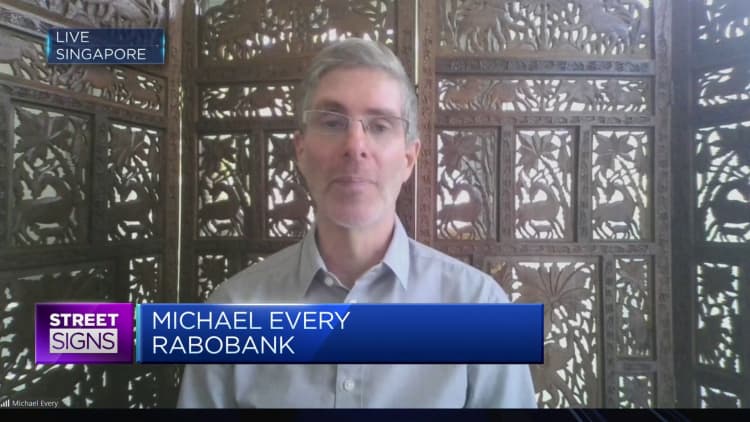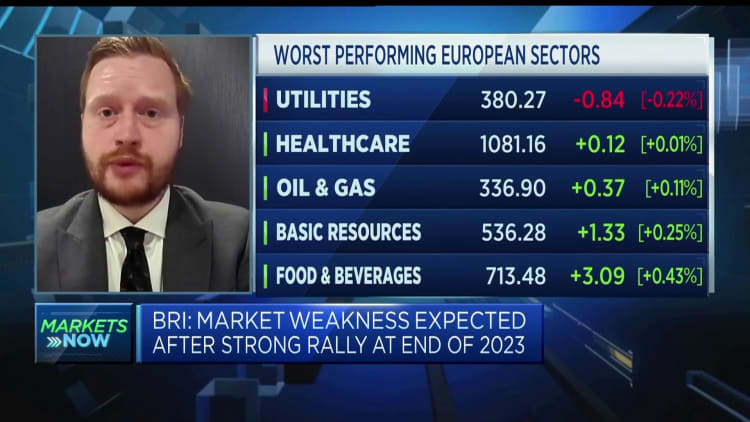Former U.S. President and Republican presidential candidate Donald Trump holds a rally in advance of the New Hampshire presidential primary election in Rochester, New Hampshire, U.S., January 21, 2024.
Mike Segar | Reuters
Markets are “fairly complacent” about the risks of a second Donald Trump presidency, which could trigger a “tantrum” in long-duration bond markets, according to Guillermo Felices, principal and global investment strategist at PGIM.
Wall Street has enjoyed a remarkable rally since November last year, culminating in both the Dow Jones Industrial Average and the S&P 500 hitting record highs on Monday.
Much of the market focus remains on short-term economic data and on what it means for the Federal Reserve’s potential interest rate cutting path this year.
Bullishness in risk assets is driven largely by the consensus that the Fed will begin cutting rates rapidly in the early part of the year, and that the U.S. economy will manage a “soft landing” — bringing inflation back to the Fed’s 2% target without triggering a recession.

Some analysts are also looking ahead through a fiscal and geopolitical lens to November’s U.S. presidential election and beyond.
Trump’s tax reform bill in 2017 cut the top corporate tax rate from 35% to 21%, and he has vowed on the campaign trail to lower it further to 15%, if he is elected to a second spell in the White House.
Risk of a ‘duration tantrum’ in bond market
In an email to CNBC on Monday, Felices said one of the developments that limited PGIM’s optimism versus the market consensus for an economic “soft landing” in the U.S. was that the market has been “fairly complacent about the risks associated with a Trump win, fiscal expansion (e.g. tax cuts, defence budgets) and military conflict escalation.”
“A Trump presidency we think would be positive for the economy in the sense that there would be probably more fiscal stimulus through state tax cuts — the question is what that stimulus does to the bond market, and what’s the backdrop for the economy?”
He explained, “If the economy is still very strong and it doesn’t really require that further fiscal stimulus, the bond market could start getting nervous about debt sustainability and higher interest rates, and therefore we could see higher yields, a bit of a duration tantrum, and risky assets wouldn’t like that.”

The U.S. economy has proven surprisingly resilient in the face of a steep increase in interest rates to combat high inflation over the last two years, with growth and employment remaining robust. Thursday’s fourth-quarter GDP growth estimate will offer further insight into how activity is faring, as the Fed tries to wrestle price increases back to target.
“If the backdrop is one where the economy is a lot weaker, and it deserves that extra fiscal push, then I think the market would be okay and would handle that in a good way — it would be supported. But it really depends on the economic backdrop that the U.S. economy is facing at that time.”
‘Fiscal risk’ at a time of high deficit
The crucial point, Felices acknowledged, is America’s deteriorating fiscal position in recent decades. The U.S. government deficit is projected to run at between 6% and 8% through to the end of the decade, and Fitch projected on Monday that this shortfall would exceed 8% of GDP annually from 2023 to 2025.
This would mean that whoever occupies the White House from January 2025 would have little room for either big government spending pledges or the type of tax cuts Trump is promising, he suggested.
“The market at the moment is not really seeing that two-sided risk. At the moment, the market is pricing in ‘Oh, central banks will save the day again, they will cut rates, and if there is some weakness in the economy, they will cut by more’,” said Felices, a former senior economist at the Bank of England.
“The market is not really focusing too much on the potential upside risks to yields that are associated with this potential repricing of term premia. [Having] fiscal risks with the sort of deficit that the U.S. is running is a really, really important one that the market will have to come to terms with again.”

As such, he suggested that both risk assets and fixed income face a “much choppier” period ahead than investors have experienced over the last year.
As well as the tax cuts, analysts have also flagged risks associated with Trump’s proposed 10% tariff on all U.S. imports, widely criticized as a net negative for the U.S. economy and consumers.
Along with a very different macroeconomic environment, particularly much higher interest rates, the broader geopolitical landscape is also unrecognizable since Trump was last in office.
Felices joined several strategists over the past week, who have argued that the former president’s famously erratic approach to foreign policy decisions carries an added risk to markets and to the economy in the current environment.
Dan Boardman-Weston, CEO of BRI Wealth Management, told CNBC on Monday that Trump’s tendency to “change his mind” on geopolitical alliances — in a world of simmering tensions between China and Taiwan alongside Russia’s war in Ukraine — would lead to “heightened risks” and an added level of uncertainty that would impact market valuations.

